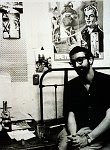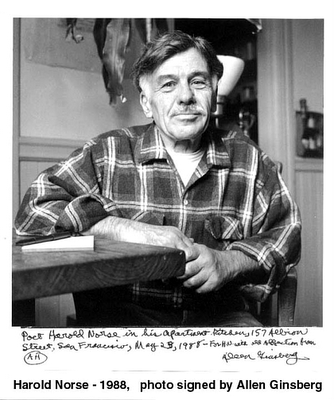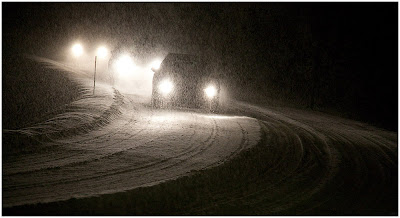
The hotel, the patronne Madame Rachou and the stair well.
Owing to the less stringent laws in force at the time,
the smoking of hashish and marijuana was, among some
of the residents, a social activit y like any other in the hotel.
The distinctive smell would, day or night, drift from
someof the ill-fitting doors on to the stairs..beat
 Hotel
Hotel



Harold Norse was part of the magical interlude of "The Beat Hotel". Along with William Burroughs and Brion Gysin he playe d a pivotal part in the seeds that led to cyberspace.
Excerpts from "Beat Hotel":
"Bob sat up straight in bed, straining to listen. Nothing. Voices crackled as from an old radio and figures strirred in some numb echo-chamber of his brain, like newspapers down a windy street. He felt enclosed in a soundproof room. He had no idea where he was. He looked around without comprehension, not even knowing what city he was in. Low rapid monologue, nervous whisper of junk journey, endless trips -- "... in Tangier, for example, I dug Arabic from Hebrew -- same language you see -- you get these programs from Radio Cario -- I can tell what they're saying -- school broadcasts for example: Little Mohammed, says teacher, what do you do when you meet a Jew? Kill him. Little Mohammed, what do you do when you meet two Jews? I call ten Arabs to kill 'em...Good-natured laughter and applause. Like Little Mohammed is six years old, dig. And didja know Jews ain't allowed to ride camels because that way they're higher than an Arab...?"
"Aladdin and Titania still in Tangier?"
"Too stoned to move...three years in the Casbah..empty palace..mosaicwalls...six kids...rush mats...a cat...a groundhog..nah, I forgot...somebody ate the groundhog...made groundhog soup..."
"Man, all they ever eat is brownies, majoun brownies...hash, honey, sesame seeds, anise, dates, cinnamon...check runs out each month...the bread goes for hash and grass...even the kids are stoned...contact high...they were conceived high, Aladdin says.,.those little girls giggle all the time...lean against each other for support and giggle...never talk ..."
"Aladdin don't say much...and Titania...has any one ever heard her say a word?"
"They're living in the UNIVERSE, man...no gas...no water...no electricity...only the blinding light of the void...in hotel universe...hotel nirvana..."
"Blue dream of space...celestial flash of blue light in crystal blue silence...on blue mosaic floors...lattice light on silent mosaic heads..."
"Aladdin's a joint machine...sits and rolls till he's catatonic...a holyroller...shit is his religion...best dealer in Tangier...you always get a good count."
"Yeh, best mind in the business...except for Leary..."
"They're buddies...on the astral plane...Communicate via astral post office... Saves money in stamps ...."
"Aladdin and Titania still in Tangier?"
"Too stoned to move...three years in the Casbah..empty palace..mosaicwalls...six kids...rush mats...a cat...a groundhog..nah, I forgot...somebody ate the groundhog...made groundhog soup..."
"Man, all they ever eat is brownies, majoun brownies...hash, honey, sesame seeds, anise, dates, cinnamon...check runs out each month...the bread goes for hash and grass...even the kids are stoned...contact high...they were conceived high, Aladdin says.,.those little girls giggle all the time...lean against each other for support and giggle...never talk ..."
"Aladdin don't say much...and Titania...has any one ever heard her say a word?"
"They're living in the UNIVERSE, man...no gas...no water...no electricity...only the blinding light of the void...in hotel universe...hotel nirvana..."
"Blue dream of space...celestial flash of blue light in crystal blue silence...on blue mosaic floors...lattice light on silent mosaic heads..."
"Aladdin's a joint machine...sits and rolls till he's catatonic...a holyroller...shit is his religion...best dealer in Tangier...you always get a good count."
"Yeh, best mind in the business...except for Leary..."
"They're buddies...on the astral plane...Communicate via astral post office... Saves money in stamps ...."
Patrick Shelley, the English sensualist painter, and AllenGinsberg, Room 25. Christmas 1956.
 Shelley introduced me to the Beat Hotel in the winter of that year.
Shelley introduced me to the Beat Hotel in the winter of that year.
photographer Harold Chapman
 Shelley introduced me to the Beat Hotel in the winter of that year.
Shelley introduced me to the Beat Hotel in the winter of that year.Light Control Panel for each of the rooms in the Beat Hotel.
The bulb glowed dimly or brightlyaccording to the amount
photographer Harold Chapman















